1940s & 1950s
1940-1945 Lydia Whitby
The following account of Lydia Whitby's schooldays in London during the 1939-45 War, not only gives information about the school during that troubled period but also gives an idea of some of the difficulties that families had to face.
Lydia Whitby was born on 28 January 1928. This is her story.
At the outbreak of the war I was a pupil at Our Lady of Sion, a convent day/boarding school in Chepstow Villas, London W11. I was eleven when I was evacuated with them to Shropshire where I remained until July 1940.
The parents of a fellow pupil, Margaret Wood, told mine of a school re-opening in Hammersmith, the Sacred Heart, who was taking a few pupils who were returning to London. At that time there were very few schools available, and the journey to Hammersmith from Notting Hill on a 27 bus was not difficult for Margaret and I.
I remember only a handful of pupils at the beginning in one or two rooms. Mother Burke was in charge and shortly after Mother Hutchinson arrived as headmistress. We seemed to play a lot of table tennis at first and as more pupils arrived back in London, serious lessons were organised.
We had Assembly every morning, and we sang the National Anthems of all of our allies in the War. I think at first we took a packed lunch. Milk was supplied, also currant buns, which were delicious at the beginning of every week, buts as they were obviously purchased on a Monday, by the end of the week they were very dry.
The air raid shelter was under the stage in the new gymnasium, very new with a strong smell of damp cement. Whenever I smell that now, it takes me back.
As we started school at the beginning of the Blitz, many lessons were interrupted by the air raid siren, and were continued in the air raid shelter. If there had been a bad raid on the previous night, we were allowed to arrive late at school the following morning, but no one ever did. As for homework, we seemed to manage to complete what had been set.
My family did not go to a shelter; we lived in our kitchen which was in a semi-basement of an Edwardian house. When a raid was taking place, we huddled under the very large solid pine kitchen table. At first, we slept under it, fully clothed (we had separate outer-wear for that purpose). Mother has a whistle round her neck in order to blow to aid any rescuers should we be buried.
After a short while we decided to sleep comfortably in our beds and hope for the best. We had a radio, and Monopoly (a new game) as well as Lexicon (a spelling game) and Belisha (a road safety game).
Travelling home from school, one always wondered if, after a daylight raid, our houses would still be standing. I arrived home one day to find the street cordoned off, as nine unexploded bombs had been dropped, obviously the result of sabotage in Germany. Another day, the barrage balloon moored in Ladbroke Square had become dislodged and was draped over the houses.
One day, walking home along Kensington Park Road, we luckily escaped being hit by a German plane, machine-gunning. Another time as the bus was rounding the corner on Kensington Church Street by the Carmelite church, the drive shouted "Everyone on the floor", as a bomb fell almost opposite.
As more and more pupils returned to London, still leaving some in Oxford where they had been evacuated to, normality returned to our school life. More classrooms were opened up and most of the staff returned from Oxford. Mother Bunbury returned and was my form mistress.
Mother Mackin taught Latin and Miss Corvesor, English. Miss Denton taught history, Miss Guessard, French and Miss Malloy, geography. Miss Wilson taught science and biology. Miss Bonser taught gym and games and Miss Vieyra, mathematics. I remember one day when Adrienne Gourju and I came to school in our new summer dresses, which almost reached the ground, Miss Vieyra spent the whole lesson pinning up the hems for us! Mrs Hall taught art, Mother Christiansen, needlework and Dr Wardle, music, which in our case was also singing.
In 1944, Mother Hutchinson was replaced by Mother Hammond as headmistress, who taught French to the Sixth Form.
As our time for School Certificate drew near, it was suggested that we go to Oxford. The 'doodle bugs' (Flying Bombs) were a new and different threat, and it was felt that we should be able to prepare for the exams in a more peaceful atmosphere. Some of the girls, previously evacuated, had not yet returned, so we were sent to join them. We were billeted all over the city and classes were held at various venues including a school near Magdalen Bridge. I used the public library as a place to study and retreat to.
Several of us returned home to London for the weekends. To my delight, it was suggested that we all had bicycles to facilitate our moving from venue to venue. On the journeys home by train, I could see the fields beside the railway tracks being filled with army vehicles and planes ready for the D-Day invasion of France.
We returned to Hammersmith to take the School Certificate, mostly in the air raid shelter under the stage in the gym, sitting elbow to elbow.
I left school after matriculation to go to Chelsea School of Art after a couple of terms at Hammersmith School of Art, much to the disquiet of Mother Hammond who washed her hands of me as all I would be doing, she said, would be sitting drawing all day.
1940-1946 Moreen Docherty (nee Currie)
1940-41
I should have started school in September 1940, but in fact, having done a test, and been interviewed by Mother Hutchinson in a little room near the main door onto Hammersmith Broadway, and having been offered a place, my parents were thinking of sending me to relatives in America for the duration of the War. Luckily this did not happen, so a term later I went to Oxford where Hammersmith was evacuated.
Oxford Lower III
Miss Guessard (French teacher) met me and took me to my billet in Summertown, then took me to 11 Northam Gardens to see Mother Hutchinson. She showed me where the school was, in a road to the right, just over Magdalen Bridge past the Botanical Gardens entrance.
Soon I became familiar with Oxford and made new friends in my class. All the places that touched our life there are mapped in my mind still. We had assembly in the main school every morning. On arrival Mother Hutchinson was at the door checking each of us as regards our clothes, demeanour, etc. After prayers Lower III often went in a crocodile, via Longwall to the music room at Holywell where we had some lessons -art was a favourite for me, with Miss Short who was soon to marry and become Mrs Freeman. Her husband was introduced to us at one assembly.
On Saturdays, we often had singing lessons in the music room when Dr Henry Wardale came up from London. Once I arrived there without plaiting my long hair and tied it with string. I'd had no idea that I was expected to plait my hair on Saturdays!
There was an arrangement for us to be entertained on Saturdays by volunteer students at one of the women's colleges, I believe it was Somerville. This was great fun and on at least one occasion meant a trip on the river followed by tea.
My first year was a time of wonder and joy because of discovering all the new areas that were open to me in history, literature, French, art and music, but also of the heartache because of being away from my family. Everybody else seemed to have similar feelings despite the fact that we did go home in the holidays.
1941-42, Upper III
A friend from Holy Cross, Maureen Woolven, arrived, and we were billeted together which was great. We lived near the Ashmolean Museum and on rainy weekends spent time there - little did I know that I was later to become an art historian!
The Sacred Heart Order was an enclosed order at this time, but circumstances meant that the nuns had to travel on buses in Oxford and for this, they needed to be escorted. As Maureen and I lived fairly near Northam Gardens, we often escorted the nuns en route. A favourite nun with whom we often walked along Longwall and through university Parks was Mother Christensen. Apart from being fun, she knew all about the different trees and plants. Many girls in my class, as in other classes, had been to the junior school in Hammersmith and told us in glowing terms about the cloisters with beautiful paintings and about the new wing [now our Stuart Building] with its gym hall and stage and the art room above it. We all wanted to go there!
1942-43, Lower IV
At the end of the summer term in 1942, our parents were informed that the school would return to Hammersmith in the Autumn term. This was exciting. Mother Hutchinson was the headmistress who bought us back and who remained Head at Hammersmith until Mother Hammond took over as Head in my Vth year.
Our return to Hammersmith for the Autumn of 1942 was not completely straightforward, in that for a time, some of the Oxford teachers had not returned and also there were girls already there, including some from Gibraltar who had joined the returning evacuees.
Not only did the cloisters live up to expectations, but there was also the chapel, the library and all the classrooms looking over the quadrangle. There were also the pre-war traditions such as retreats, Horseferry Road contemplation, feast-days, celebration of Shakespeare's birthday, the Literary Society, the History Guild, Guides, visits to the theatre and to the Albert Hall. It was the richest of times.
I pay tribute to the teachers who were instrumental in making it so: Miss Corvesor, Miss Denton, Miss Wilson, Miss Vieyra, Miss Guessard, Miss Molloy, Miss Bonser, Mother Mackin and indeed, Mother Hutchinson who was so astute in recognising the potential in us as individuals. She was strong and fair. I kept in touch with her after I left Hammersmith. Dear Mother Christiansen put up with some awful needlework and tried to teach us German. We loved her! The art teacher, Mrs Hall, inspired me.
1943-44, Upper IV
The flying bombs of 1944 disrupted harmony and were terrifying. The school used to do downstairs to the cloakrooms when the sirens sounded. I missed some schooling because we were sent to relations in Cornwall. Mother Hutchinson was encouraging, and I returned to catch up and work hard.
1944-46, Forms V and VI
Mother Hammond was headmistress during my fifth and sixth years. Personally, I missed Mother Hutchinson but, of course, Mother Hammond brought her own style and ideas. One highlight was the first Gilbert and Sullivan opera, the Mikado. We all had to audition in front of Dr Wardale and Sr. Marie Therese (not a Sacred Heart nun). I learned that I was to be Nanki-Poo but later because of my mother's sudden illness, I was needed at home to help with Catherine (born 1942), so I concentrated on enjoying chorus work.
Only about six of us stayed on after School Certificate. We were a very artistic sixth form, often giving concerts. Three of us joined the London Philharmonic Choir.
Our subjects for Higher School Certificate included Latin, French, history and English. I was sorry that no space was left for my art development. The one aspect of my education that was lacking was science, apart from some biology and chemistry which we did in the earlier years. As regards careers advice, this was minimal and the expectation that the pupils would become teachers (Digby Stuart), nurses or secretaries. There was no mention of university as far as I remember but some of us were to get degrees later in life (in my case by private study and help from The Courtauld Institute)
Rather stupidly, I left before my second year in Form VI, to go to Chelsea School of Art. I became an art teacher and Mother Hammond asked me to teach at Hammersmith, but I was not able to because of the birth of my baby. I returned to teach at Hammersmith during the years 1964-1967.
It was good that Hammersmith saw the education of girls as something to be valued!
1942-1947 Adrienne Gourju
Adrienne Gourju joined the school in January 1942 and left in 1947 to continue her education at London University, where she obtained an honours degree in science and a Ph.D. in biochemistry - a great achievement when the teaching of science subjects in many schools such as Hammersmith at that time, was not considered to be a priority.
I joined the school in January 1942, just before my thirteenth birthday. There was only one form as all the older children we still evacuated up in Oxford and did not return until September of that year. The class was in the room above the stage and the teacher was Mother Bourke. Many of the lessons such as history were from the 'wireless'.
When school returned, Mother Hutchinson was headmistress until succeeded by Mother Hammond. Miss (actually Dr.) Corvesor taught English; Miss Guessard, French; Miss Vieyra, maths; Miss Wilson, biology; Miss Molloy (and ex-pupil), geography; Miss Denton, history; Mother Mackin, Latin; Dr Wardale, singing; Mother Christianssen, needlework; Miss Bonser, games and gym; and Mrs Hall, Art (an excellent teacher). Mother Bourke left to become a missionary in India and appeared on the stage during one assembly, dressed in her tropical kit, looking very embarrassed.
Dr Wardale produced the Mikado one year. Those of us who could not sing but had parts, were allowed to speak them -this included me who played Pooh Bah. School societies included History, Biology and English. Miss Bonser ran a Girl Guide group.
Games consisted of netball, rounders and tennis, and by the time I left, hockey was played in playing fields away from the school.
My year took the School Certificate examination in June 1944, when the doodlebugs (flying bombs) were attacking London. We were in a room under the stage -quite why this was considered the best place, I do not know for I do not remember any reinforcing of glass for protection.
I wanted to read Science at university and until 1944, only biology was taught in the school. Then Miss Boyle, who taught chemistry joined the staff. She taught me on my own for that year and Mother Christianssen, who was Danish, taught me German. I sat both School Certificate exams in 1945. Then I continued with biology at Sacred Heart and went to Godolphin and Latymer for Higher School Certificate chemistry and physics.
I was Head Girl 1946-47. Girls in my year included: Lydia Whitby (who had been with the school to Oxford and with whom I am still great friends); Moira McLaughlin; Anne Girdlestone (French); Elizabeth ? (a Gibraltarian girl); Pax Tenant (who went to Digby Stuart); Norma Simpson (became Carol Marsh, the film star in Brighton Rock); Anne Sheridan; Mary McComish (who became a Sacred Heart nun); Eileen Robinson and Sheila Ingram.
1942-1949 Helena Fones (nee Currie)
It was September 1942 when I started at the Convent of the Sacred Heart High School for Girls. My sister had been at Oxford during the school evacuation there and I was very excited at the thought of joining her.
When we returned to school in London after the evacuation, things appeared quite quiet but every so often there would be night-time air raids and after spending nights in our garden Anderson Shelter, we would go to school the next day as usual. Later the V1 and V2 bombs came during the day, which was again very frightening.
I have fond memories of all the nuns and teachers. Mother Hutchinson was headmistress when I started school. She would stand at the school entrance watching us all. On one occasion I was beckoned over by her as I was limping because of chilblains on my heels. She asked if my mother was giving me 'Virol', to which I replied "No, but she is putting 'Milton' on them". Looking back, she took a real interest in the children.
Considering that there was a war on, we had many interesting activities in the school. The History Guild was run by Miss Denton. We would perform plays and dress up in her magical clothes, which were kept in trunks. Miss Bonser the games' mistress was very tall. She was responsible for measuring our feet during the clothes rationing period to see if we were eligible for extra clothing coupons. Unfortunately, my feet never reached size 5 in order to qualify, even after no end of stretching!
Little Mother Mackin was loved by all. She had such a strong voice for such a tiny person. We also enjoyed our art classes taken by Mrs Hall and Biology taken by Miss Wilson, another wonderful teacher. Mother Christiansen was a kindly nun who took us for needlework. She would read to us during the sewing period - 'St Theresa of Lisieux' comes to mind!
Mother Bourke was Mistress of Discipline. We missed her terribly when she went to India (but lucky India!).
We had singing and music from the two Dr Wardales, Joseph and Henry. We actually performed 'The Mikado' in the gym hall. We knew every song from The Mikado by heart and I still sing them to my grandchildren!
The chapel featured very much in our school lives. We had Benediction on Friday afternoons and Mass on the first Friday of the month. I loved the plainchant and Latin as it somehow seemed more holy than the English version! After the First Friday Mass we went into the dining room where we were given fruit buns and sponge cakes, supplied by Joe Lyons (Cadby Hall) which was just along Hammersmith Road.
I think we were very privileged to have been educated at the Sacred Heart. I loved the gentleness of everything then, and the good manners. It certainly gave us something that we have never lost.
1944-45 Betty Cairns
Betty Cairns (née Mann) gives an interesting account of an incident that happened on the way to school -and how the school dealt with it!
My friend Chrissy and I, aged between 11 and 12, attended the Sacred Heart School in the last years of the war, around 1944. We both lived off the Old Brompton Road and went home to lunch each day on the underground. On one particular day, we were heading for Gloucester Road tube and despite five years of war, wore white cotton gloves, white socks, and in Chrissy's case, a superb straw panama hat that had belonged to her mother.
It was the time of the 'doodle-bugs' - unmanned rockets which were fired indiscriminately against the civilian population. The rockets came over, unannounced, cut their engines and came down.
On that day we heard the buzz, the cut-out and with one accord flung ourselves into the gutter. We were lucky. The bomb destroyed a house on the opposite side of the road. We were showered with dust, but the blast went away from us, so we were not injured. We picked ourselves up, and the various rescue services ascertained that we were unhurt and left us to our own devices.
I remembered asking the time, and we were late back from lunch! We dusted each other down. So much for the white gloves...so much too for the prized panama hat! I had fallen on it. We pushed it back into shape and Chrissy jammed it on her head, and we ran for the station.
We had of course, to go to the main school entrance in the Broadway. The gentle little portress fussed around us, asking if we were alright and then went off to fetch 'Higher Authority'.
Higher Authority was made of sterner stuff and seeing that we were unhurt said that we were late and a disgrace to the school. The panama hat seemed to cause her most pain! (Looking back, I think she was trying not to laugh).
We deserved 2 order marks, she said, one for lateness and one for appearance. However, if we promised not to let it happen again....solemnly we promised not to be bombed again. A promise, I am happy to say, we managed to keep. It never occurred to us that we were being treated unsympathetically - perhaps the milk and cake that we were given made up for it!
Things were different then, both in and out of school, stricter and tougher. But looking at my contemporaries from a distance of more than 60 years, perhaps it was a good thing for children growing up in a World War.
My memories of the time I spend at Sacred Heart, are very happy ones.
1948 Grena Norton (nee Watkins)
In 1948, it was normal routine to catch the No 72 bus to Roehampton, via Hammersmith Bridge, to play hockey at the Roehampton Sports Field. It was a double lesson in order to get there, play hockey and return to Sacred Heart Convent (SHC). Miss Brown (a lay teacher) was in charge. One day she said to me “Grena Watkins, if you don’t wear your long mac on hockey day (to cover my modesty!), you won’t be allowed on Hammersmith Broadway in your divided skirt (long shorts).” Miss Bonser was also a games' teacher, she usually wore a green tunic and tights.
I clearly remember the day that King George VI died: a friend called out of the Art Room window in 1952 [the Art Room was above what is currently our old gym] to the netball court below “the King has died”.
I often think of the beautiful Cloisters. We were not allowed to touch the magnificent colourful artwork and had to file silently through to the Dining Room at the end of the corridor for lunch. Marrow was usually the vegetable of the day, with spotted dick and custard for pudding. (The Second World War had only been over for a few years, and we were just pleased to eat anything and everything!)
In 1941, I stayed with “Aunt” Sylvia in Horsley, a family friend. When I subsequently went to SHC, I was surprised to see her name, Sylvia Newman, on the role of honour in the Refectory.
On the first Friday of the month (I think), we attended Mass in the Chapel before school - where have all the beautiful wooden pews gone? [We're working on that!] We had breakfast in the Refectory after Mass. At the time, I lived in Cobham and caught the 715 Green Line coach through to SHC Hammersmith.
I did not excel in many subjects, except hockey, even though I had achieved an Eleven Plus Scholarship. However, my days at SHC in Hammersmith will always be remembered with great love and affection.
I still have a few treasures from my School days – I have scanned photos of them …. I hope you can read/see them clearly.
The first is my little red prayer book: 'Manual of Prayers for the Children of the Sacred Heart -seventh edition -1948'. On the back inside cover, I have written a list of girls names (including Josephine Newman, who features later). I wonder if any of these girls are still around? I can’t quite read some of the names: J Kelly, J Taylor, C Grey, E Welsh, Maloy, Crabb, Connel, Coats, Essery, D Kelly, M Hayden, M Kelly, J Newman.
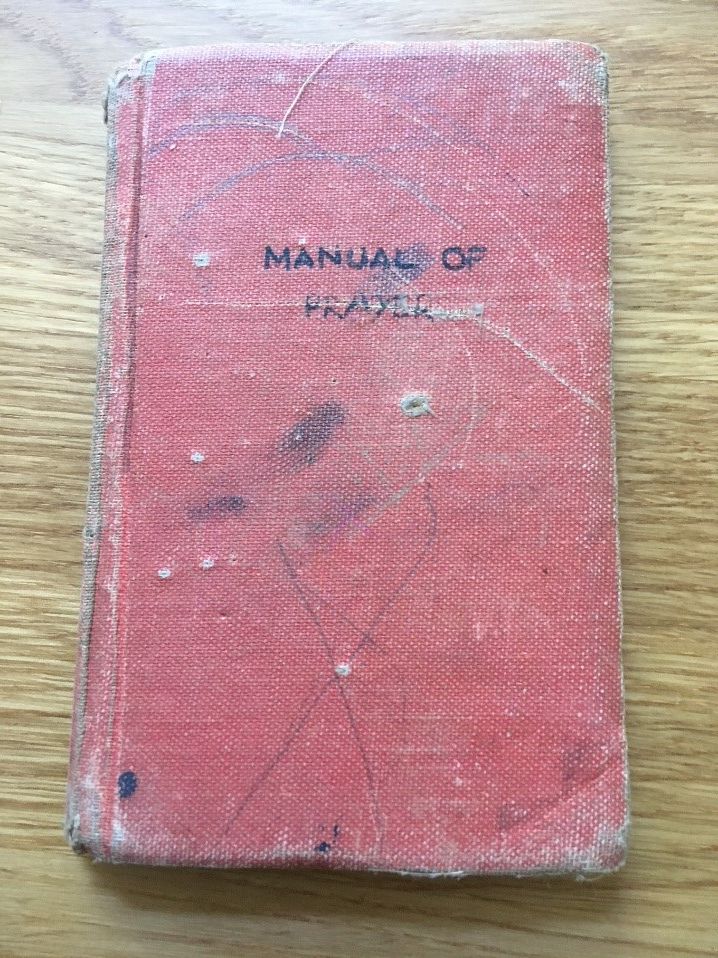 |
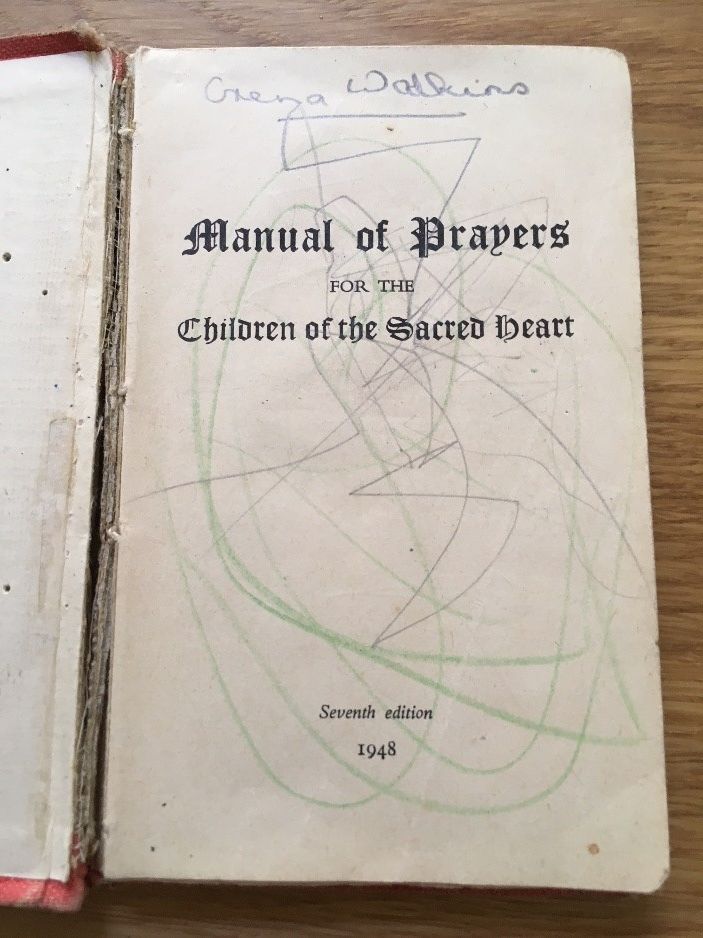 |
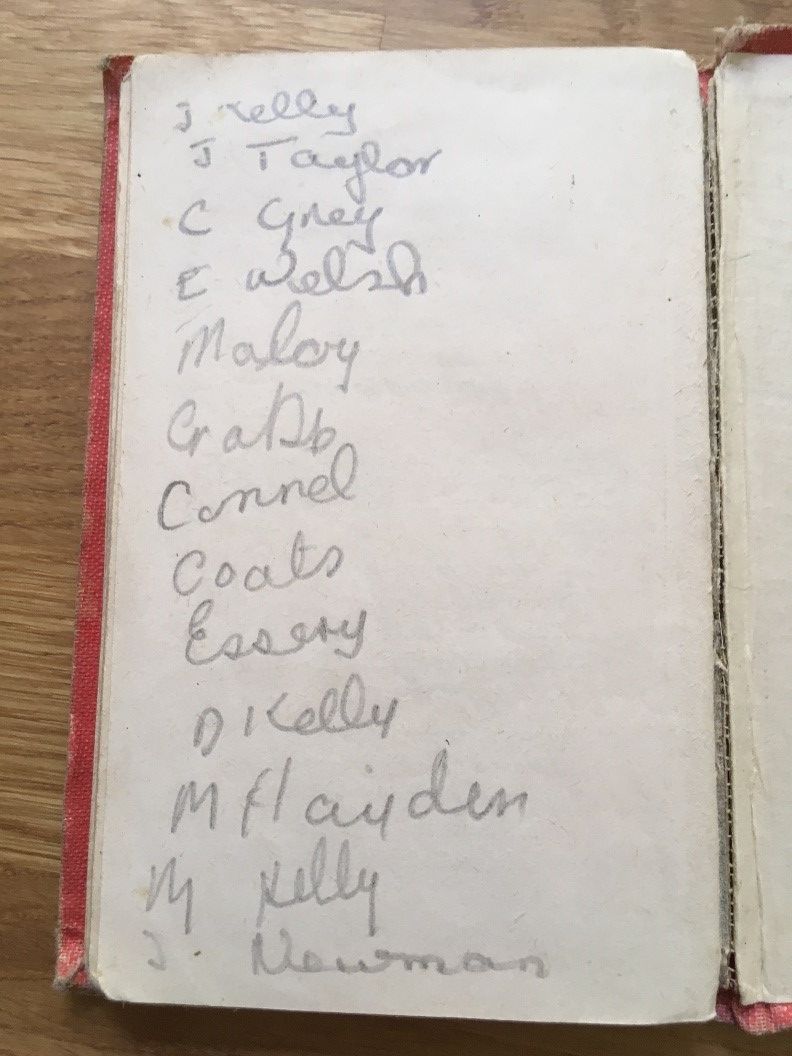 |
Below you can see a little verse that Mother Mackin wrote in my autograph book – it reads: 'July 1950. Are we not thy chosen soldiers, children of the Sacred Heart? With best wishes from M Mackin'. Adjacent to that is a holy picture sent to me from Mother Hammond (headmistress) at Christmas. On the back, she has written: 'Grena, with love and very many thanks for the beautiful calendar. Best wishes to you all, G Hammond'.
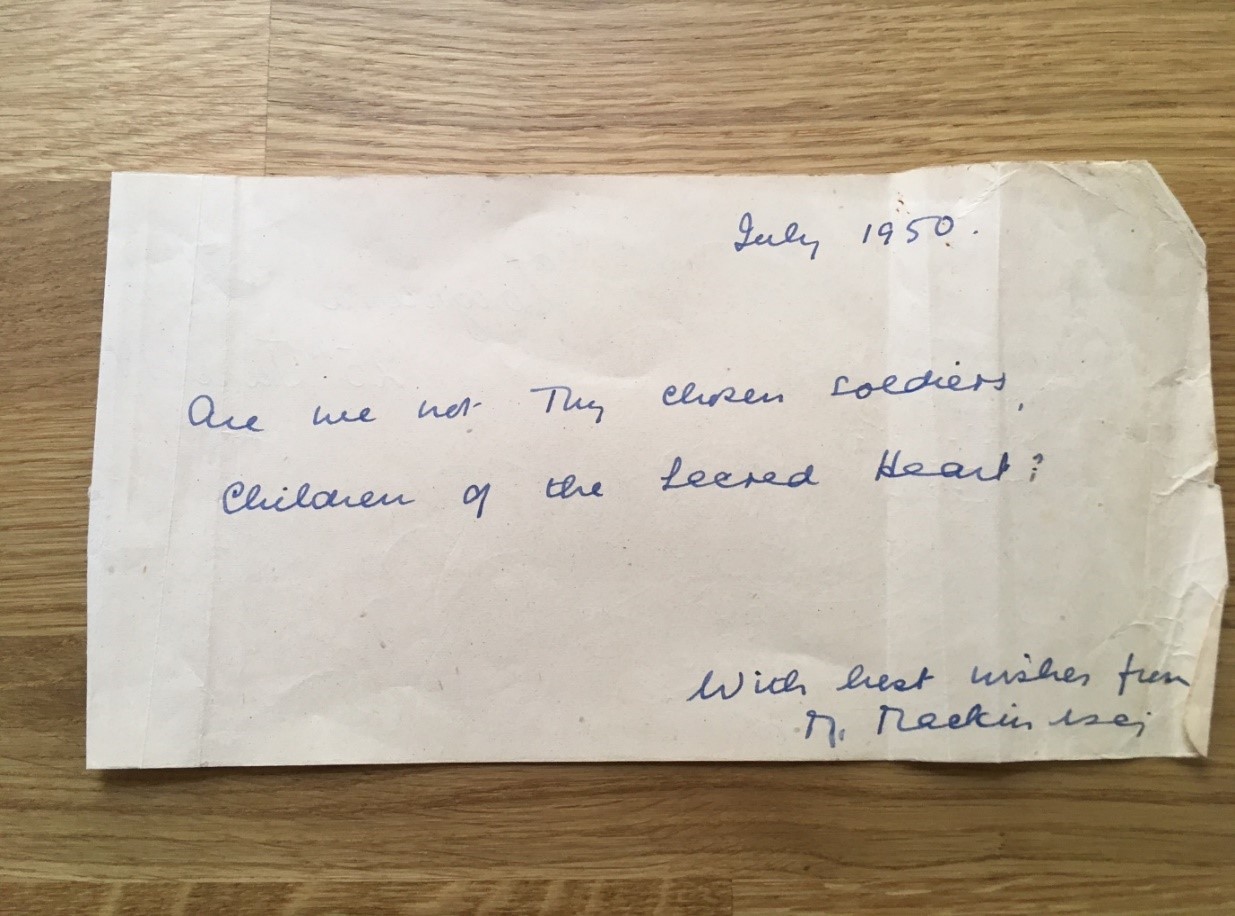 |
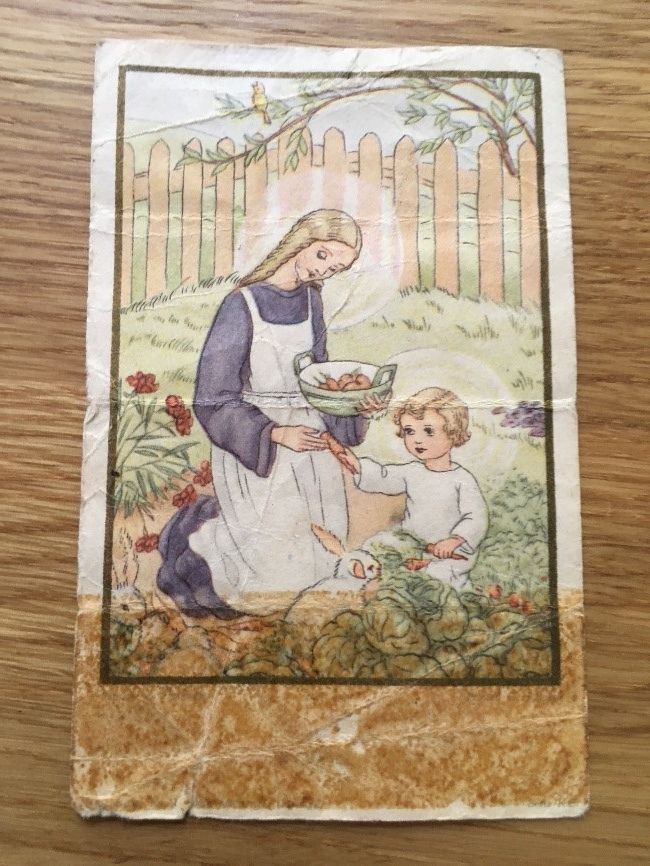 |
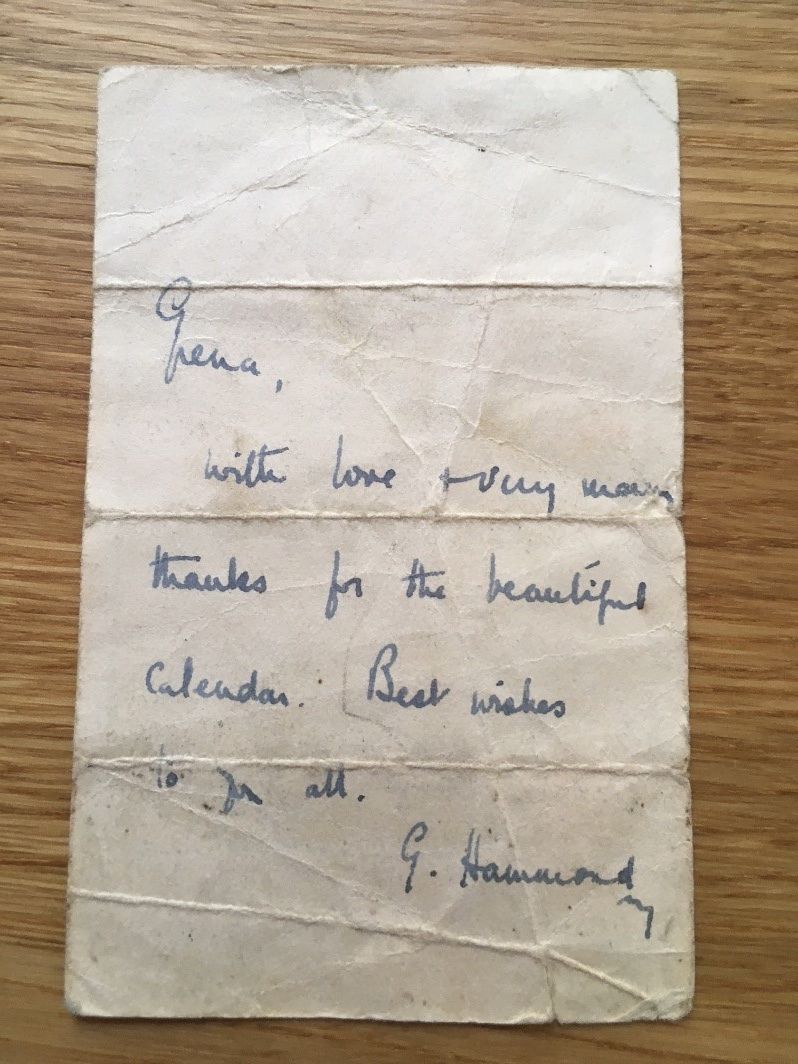 |